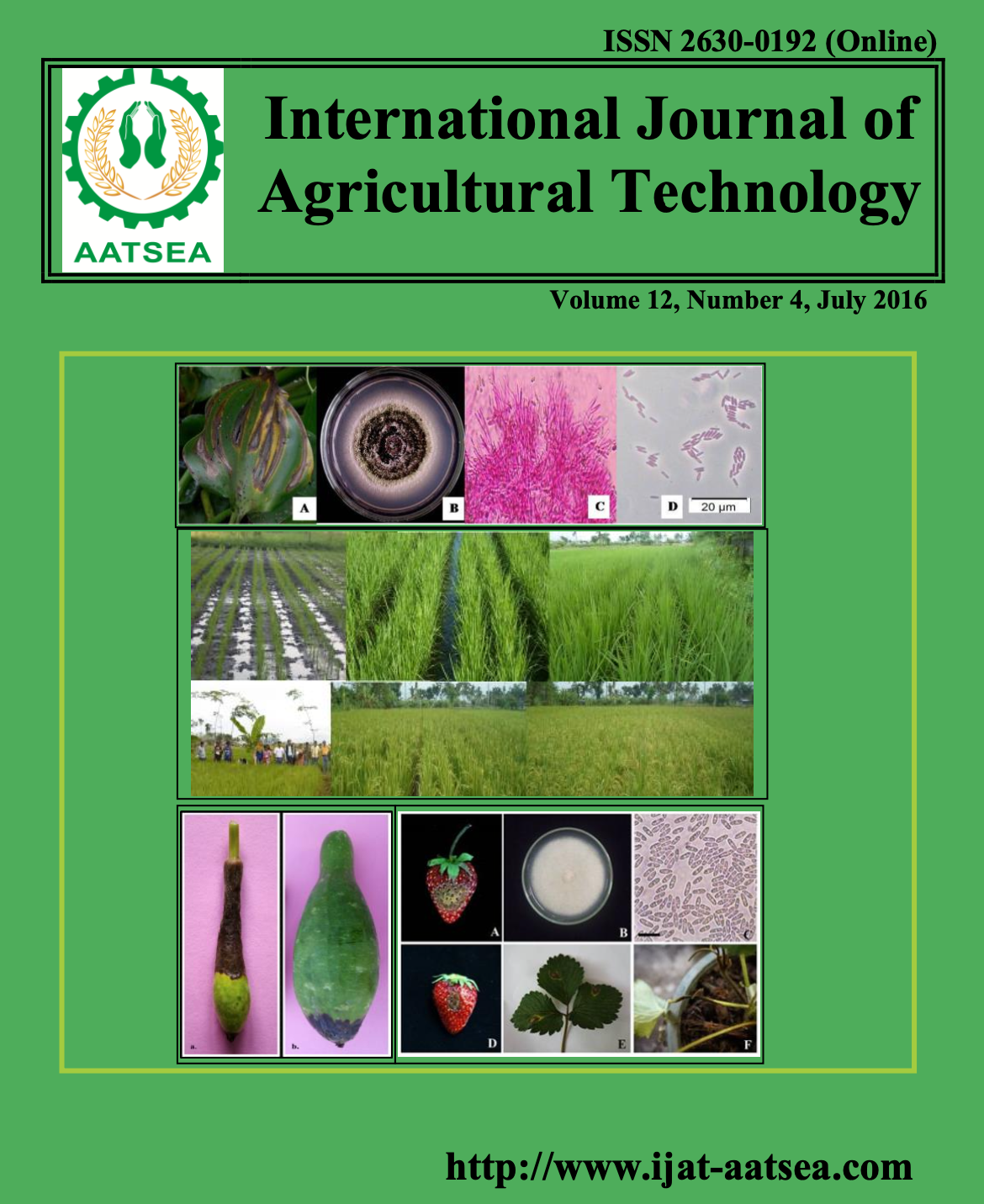Reuse of wastewater for crop production: Effects on macronutrients content of celosia argentea vegetable
Main Article Content
Abstract
Uses of wastewater in agriculture are a viable option in solving water scarcity, food security and improving environmental hygiene. Vegetable being a good source of plant protein, fat and carbohydrates is not readily available round the year due to shortage of irrigation water. Effect of wastewater irrigation on the macronutrients contents of Celosia argentea vegetable was investigated. Three wastewater types (laundry/bathroom, BW, abattoir wastewater, AW and cassava effluent, CE) were used to grow the vegetable in potted experiment. The vegetable was also grown with rainwater to serve as a control. Harvested vegetable from the different wastewater treatments were analyzed for their macronutrient contents. The Analysis of variance (ANOVA) of the results was performed at a confidence level of 95 % (p < 0.05), and the mean was separated using DMRT in Statistical Package for Social Sciences (SPSS). Analyses revealed that protein content of the vegetable decrease in the order BW (18.03%) > AW (15.64%) > CE (8.68%) > RW (8.52%). The fat content was in the order AW (6.27%) > BW (5.95%)> CE (4.72%) > RW (4.22%). The effect of different wastewater used was not significantly different on carbohydrate content of the plant which is between 24.9 and 26.0%. The effect of the treatments on the moisture content of plant was found not to be significantly different from the control (p< 0.05) (AW (11.24%); BLW (11.01); CE (11.23) and RW (11.23)).
The results of the experiments show that irrigating with wastewater improves the macro nutrients of Celosia argentea vegetable. It however recommended that more works be done on wastewater effect on other proximate values of the vegetables.
Article Details

This work is licensed under a Creative Commons Attribution-NonCommercial-NoDerivatives 4.0 International License.
References
Ajiboye, A. A., Fadimu, O. Y., Ajiboye, M. D., Agboola, D. A., Adelaja, A. B. and Bem, A. A. (2014). Phytochemical and nutritional constituents of some common vegetables in south-western, Nigeria. Globaal journal of science frontier Research: C Biological Science XIV 48-53.
APHA (1998). Standard methods for examination of water and wastewater, 20th.American Public Health Association, Washington, DC, USA.
Asaolu, S. S., Adefemi, O. S., Oyakilome, I. G., Ajibulu, K. E. and Asaolu, M. F. (2012): Proximate and mineral composition of Nigerian leafy vegetables. Journal of food Research 214-218.
AOAC (1997). Methods of Analysis of Association of official Analytical Chemists (16thed.). 1:600-792.
Coker, A. O., Olugasa, B. O. and Adeyemi, A. O. (2001) Abattoir wastewater quality in South Western Nigeria”.Proceedings of the 27th WEDC Conference. Lusaca, Zambia 329-331.
Darrel, V. (2002). Rule development committee issue research report draft organic loading rates. tumwater, WA, Washington State Department of Health, Wastewater Management Program.
Ihekoronye, A. I. and Ngoddy, P. O. (1985). Tropical fruits and vegetables. In integrated food science and technology for the tropics. Macmillian Publisher, London.
Zavadil, J. (2009). The effect of Municipal wastewater irrigation on the yiel and quality of vegetables and crops. Soil and Water Research 4:91-103.
Leung, W. T. W., Busson, F. and Jardin, C. (1968): Food Composition table for use in Africa, F.A.O, Rome, Italy. 306 pp.
Ogungbenle, H. N. and Ebadan, P. (2014): Nutritional qualities and amino acid profile of Velvet Tamarind (Dalium guineense) pulp Bri. Biomed Bull 2:006-016.
Ogungbenle, H. N. and Otemuyiwa, F. F. (2015). Food properties and Amino Acid Composition of Celosia Spicata leaves. Advances in Analytical Chemistry 5:1-7.
Olaofe, O., Adeyeye, E. I. and Olugbo, S. (2013): Comparative study of proximate amino acid and fatty acids of Moringa olifera tree Elixir. Applied chemistry 12543-12554.
Onunogbu, I. C. (2002). Lipids in human existence. 1st Edition AP Exxpress publishing company. Nsukka. Nigeria. pp.1-15.
Osibajo, O. and Adie, G. U. 2007.Impact of effluent from Bodija Abattoir on the physico- chemical parameters of osinkaye stream in Ibadan city, Nigeria. African Journal of Biotechnology 6:1806-1811.
Philip, C. N. A. and Owen, O. J. (2014). Evaluatio of the chemical and phytochemical constituents of Alchornea cordifolia leaf meal as potential feed for monogastric livestock, International Journal of Pharmaceutics and Drug Analysis 2:360-368.
Rumeza, H., Zafar, I., Mudassar, I., Shaheena, H. and Masooma, R. (2006). Use of vegetables as nutritional food: role in human health. Journal of agricultural Biological science 1:18-22.
Saidu, A. N. and Jideobi, N. G (2009). The proximate and elemental analysis of some leafy vegetables grown in Minna and Environs. Journal of Applied Science Management 13:21-22.
Scott, C., Faruqui, N. I. and Raschid, L. (2004). Wastewater Use in Irrigated Agriculture.Confronting the Livelihood and Environmental Realities. Retrieved From http://www.idrc.ca/en/ev-31595-201-1-DO_TOPIC.html.
Tanya, A. K. N., Botung, M. and Kesinro, O. O. (1997). Soluble and insoluble firbr contents of some Cameroonian foodstuffs. Plant Foods for Human Nutrition 51:199-207.
U. S Department of the Interior, U. S, Geological Survey (2013). Retrieved From http://water. Usgs.gov/edu/qa-home-percapita.html.
WHO (2006). Guidelines for the safe use of wastewater, excreta and greater. Vol. 3. World Health Organisation Press, Geneva, Switzerland.
World Bank (1995). Nigeria Strategic Options for Redressing Industrial Pollution. Word Bank, Industry and Energy Division. West Central Africa Department 2:60-62.
Yekeen, T. A., Akintaro, O. I., Akinboro, A., and Azeez, M. A (2013). Evaluation of cytogenotoxic and nutrient composition of three commonly consumed vegetables in south-Western Nigeria. Journal of Food Agriculture, Nutrition and Development 13: 7452-7466.


